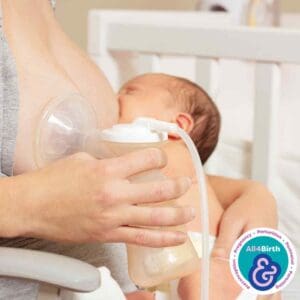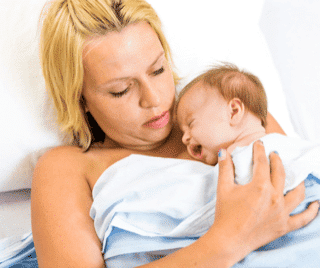Abbie Tomson
Midwife MSc, BSc, Yoga Teacher, Project Lead at All4Birth
@enevlorel @All4Birth
Summary
As a mother-to-be or a new parent, the journey of pregnancy, birth, and parenting brings along a plethora of emotions and experiences. Among the joys and challenges, one aspect that many mothers may encounter during their breastfeeding journey is mastitis. Understanding what mastitis is, how it occurs, and how to manage it can significantly impact both maternal well-being and the breastfeeding relationship with your baby.
Anatomy and Physiology of Mastitis: 1
Mastitis is an inflammation of the breast tissue, specifically in the lobes. Anatomically, the breasts consist of glandular tissue responsible for milk production, as well as ducts that transport milk to the nipple. When these ducts become blocked or milk is not adequately removed from the breast, it can lead to inflammation and, subsequently, mastitis. This inflammation can cause symptoms such as breast pain, redness, swelling, warmth, and sometimes fever.
The exact causes of mastitis are not well understood, but it is often associated with several factors such as milk stasis (when milk does not properly flow through the ducts), bacterial infection, stress, and nipple damage. Milk stasis, often caused by a blocked milk duct or other disruption to milk flow, can create pressure that forces milk into surrounding tissues, instigating inflammation.
First Exposure to Bacteria:
Interestingly, mastitis might be one of the first ways babies are exposed to bacteria from their mothers. During breastfeeding, bacteria from the baby’s mouth can enter the milk ducts through small cracks or openings in the nipple. While this exposure is a natural part of the breastfeeding process, it can sometimes lead to infection if not properly managed.
Signs and Symptoms: 1
– Flu-like muscle pain (myalgia)- Fever and chills
– Skin discolouration ranging from pink to bright red over the affected area
– Pain in a specific area of the breast
– Shiny and taut skin appearance
– Presence of a lump or hardened area in the breast
– Pain when moving the ribcage or arm, or from breast tissue jarring during walking
– Overall feeling of being very unwell or ill
Risk Factors: 2
- Breastfeeding technique: Improper latching or infrequent feeding sessions can lead to ineffective milk removal, increasing the risk of blocked ducts or engorgement. A tongie tie could also be affecting this.
- Engorgement: When the breasts become overly full with milk, it can compress the milk ducts, leading to blockages.
- Cracked nipples: Cracks or wounds on the nipples provide an entry point for bacteria, increasing the risk of infection.
- Stress and fatigue: Exhaustion and stress can weaken the immune system, making mothers more susceptible to infections like mastitis.
- Tight clothing compressing part of the breast
- Physical issues such as poor posture or shoulder pain that hinder effective breast drainage
- Sudden cessation of breastfeeding
Home Remedies to Ease Mastitis: 1
While mastitis can be uncomfortable, there are several home remedies that mothers can try to alleviate symptoms and promote healing:
- Feeding on-demand breastfeeding: Emptying the breasts regularly helps to clear blocked ducts and relieve engorgement. Continue feeding as normal, don’t add any extra feeds and avoid pumping or expressing if this isn’t something you usually do
- Cool compresses: Applying cool compresses to the affected breast can help to reduce pain and inflammation by reducing the extra fluid and inflammation, some people may find warm comfortable but it could increase the inflammation.
- Light-touch Massage: Gently massaging the breast away from the red area, towards the underarm can help to unclog blocked ducts and works based on lymphatic massage. Do not perform any deep massage, especially not using an electric toothbrush as this can increase the inflammation! 3
- Rest and hydration: Ensuring adequate rest and staying hydrated can support the body’s immune response and aid in recovery.
- Anti-inflammatory medications: such as ibuprofen can help with pain and decrease swelling.
When Antibiotics are Necessary: 2
In some cases, mastitis may not improve with home remedies alone, and antibiotics may be required. Antibiotics are typically recommended if:
- Symptoms do not improve within 24 to 48 hours of home treatment.
- The mother develops a high fever or flu-like symptoms.
- There are signs of a breast abscess, such as a localized area of redness, warmth, and tenderness.
- There is a protocol on the ‘Academy of Breastfeeding Medicine which may be useful to mention to your health professional
-
However, if you are AT ALL concerned, contact your local maternity helpline or GP/111 as advised by your local area guidance
Prevention for the Future: 2
- Ensure proper breastfeeding technique: Seek assistance to ensure proper latching and positioning during breastfeeding, ensuring effective milk removal.
- Maintain breast health: Avoid tight clothing or bras that can constrict milk flow, and address any cracked nipples promptly.
- Manage engorgement: Feed on demand and use techniques such as hand expression or pumping to relieve engorgement, but avoid overexpressing or overpumping, as oversupply will cause as many issues.
- Take care of yourself: Prioritise self-care, including adequate rest, nutrition, and stress management, to support overall health and immune function.
- Consider probiotics: there is limited evidence available currently, but probiotics are thought to support the breast microbiome and prevent inflammatory mastitis becoming bacterial mastitis. A trial showed that probiotics were effective for treatment and prevention, but there were limitations noted in the included trials. 4
Conclusion
Mastitis can be a challenging aspect of the breastfeeding journey, but with understanding, support, and proper management, it is often temporary and manageable. By being aware of the risk factors, employing home remedies, knowing when to seek medical intervention, and taking preventive measures, mothers can navigate through mastitis with confidence, ensuring a positive breastfeeding experience for both themselves and their babies. Remember, you are not alone, and support is available every step of the way.
Links to other resources
 Books
Books
The Positive Breastfeeding Book By Amy Brown
The Mindful Breastfeeding Book: Preparing you for Calm and Connected Feeding By Anna Le Grange
Breastfeeding and the Fourth Trimester by Lucy Webber
 Websites
Websites
La Leche League GB – Friendly breastfeeding support from pregnancy onwards
Breastfeeding | Feeding Your Baby | Start for Life (www.nhs.uk)
References
- Academy of Breastfeeding Medicine Clinical Protocol #36: The Mastitis Spectrum, Revised 2022
- Wilson, E., Woodd, S. L., & Benova, L. (2020). Incidence of and Risk Factors for Lactational Mastitis: A Systematic Review. Journal of human lactation : official journal of International Lactation Consultant Association, 36(4), 673–686. https://doi.org/10.1177/0890334420907898
- Witt, A. M., Bolman, M., Kredit, S., & Vanic, A. (2016). Therapeutic Breast Massage in Lactation for the Management of Engorgement, Plugged Ducts, and Mastitis. Journal of human lactation : official journal of International Lactation Consultant Association, 32(1), 123–131. https://doi.org/10.1177/0890334415619439
- Barker, M., Adelson, P., Peters, M. D. J., & Steen, M. (2020). Probiotics and human lactational mastitis: A scoping review. Women and birth : journal of the Australian College of Midwives, 33(6), e483–e491. https://doi.org/10.1016/j.wombi.2020.01.001













